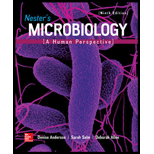
Nester's Microbiology: A Human Perspective
9th Edition
ISBN: 9781259709999
Author: Denise G. Anderson Lecturer, Sarah Salm, Deborah Allen
Publisher: McGraw-Hill Education
expand_more
expand_more
format_list_bulleted
Concept explainers
Question
Chapter 21, Problem 3SA
Summary Introduction
To review:
The location of the gene for diphtheria toxin production.
Introduction:
Diphtheria is caused by the bacterium Corynebacterium diphtheriae. It is a disease mediated by a toxin. The bacteria can produce an exotoxin that is responsible for the disease. The gene of this toxin is carried by a specific bacteriophage following a lysogenic life cycle. This is an example of lysogenic conversion.
Expert Solution & Answer
Want to see the full answer?
Check out a sample textbook solution
Students have asked these similar questions
What are the most characteristic symptoms of diphtheria and why was this disease so deadly prior to the use of the vaccine?
is diphtheria a primary or secondary infection?
All of the following are true of diphtheria excepta) a membrane that forms in the throat can cause suffocation.b) a toxin is produced that interferes with ribosome function.c) the causative organism typically invades the bloodstream.d) immunization with a toxoid prevents the disease.e) nerve injury with paralysis is common.
Chapter 21 Solutions
Nester's Microbiology: A Human Perspective
Ch. 21 - Prob. 1SACh. 21 - After you recover from strep throat, can you get...Ch. 21 - Prob. 3SACh. 21 -
4. Why has no vaccine been developed for the...Ch. 21 - Prob. 5SACh. 21 - Prob. 6SACh. 21 - Prob. 7SACh. 21 - Prob. 8SACh. 21 - Why did it take so long to discover the cause of...Ch. 21 - Prob. 10SA
Knowledge Booster
Learn more about
Need a deep-dive on the concept behind this application? Look no further. Learn more about this topic, biology and related others by exploring similar questions and additional content below.Similar questions
- Chlamydia trachomatis is a sexually transmitted infection. The organism can be classified in different serotypes. A) what cellular component determines the serotype? B) Describe the three different main groups of serotypes and the corresponding clinical diseases.arrow_forwardAll of the following are true of Rocky Mountain spotted fever excepta) the disease is most prevalent in the western United States.b) it is caused by an obligate intracellular bacterium.c) it is a zoonosis transmitted to humans by ticks.d) those with the disease characteristically develop a hemorrhagic rash.e) antibiotic therapy is usually curative if given early in the disease.arrow_forwardWhat are the mitigating measures to prevent the escalation of the black Sigatoka disease? Explain.arrow_forward
- Why is erysipeloid an occupation-associated infection?arrow_forwardChlamydia may result in any of the following except A) urethritis in males. B) neonatal conjunctivitis. C) pelvic inflammatory disease in women. D) severe neurological disorders such as seizures, vertigo, memory and sensory impairment, and paralysis. E) pelvic pain with fever in women.arrow_forwardWhich one of the following statements about bacterial vaginosis is false?a) It is the most common vaginal disease in women ofchildbearing age.b) In pregnant women, it is associated with premature delivery.c) Inflammation of the vagina is a constant feature of the disease.d) The vaginal microbiota shows a significant decrease inlactobacilli and a marked increase in anaerobic bacteria.e) The cause is unknown.arrow_forward
- Write the scientific name of causative agents of :--i) Syphillisii) Gonorrhoea.arrow_forwardWhat is the cause of malaria? Why does the presence of sickle cell trait confer resistance to some types?arrow_forwardWhich of the following would lead to a rise in hematopoiesis? A) Nutrient-deficient diet B) Kidney failure C) An infection D) Low levels of hypoxia-induced factorarrow_forward
arrow_back_ios
SEE MORE QUESTIONS
arrow_forward_ios
Recommended textbooks for you
- Case Studies In Health Information ManagementBiologyISBN:9781337676908Author:SCHNERINGPublisher:Cengage

Case Studies In Health Information Management
Biology
ISBN:9781337676908
Author:SCHNERING
Publisher:Cengage


